Unit 9 Assignment: Strategic Training in Healthcare Workforce Policies
VerifiedAdded on 2023/06/10
|12
|2412
|103
Report
AI Summary
This report, developed as an action plan, addresses the critical need for strategic training within the healthcare workforce, particularly concerning medical coding and billing practices. The report begins with an introduction outlining the importance of training strategies for hospital development, emphasizing policies, regulations, and procedures. It then delves into policies and procedures designed to monitor and mitigate healthcare fraud and abuse, including the identification of various types of abuse such as service unbundling, inflated bills, and phantom billing. The report proceeds to detail implementation strategies for staff orientation and training programs, covering aspects such as introducing new employees, outlining hospital regulations, and establishing evaluation periods. Furthermore, it examines the evaluation of initial and ongoing training programs, including orientation, on-board training, soft skills development, and product/service training. The report concludes with a discussion of enterprise-wide information assets, specifically the importance of an Enterprise Data Warehouse (EDW) to support organizational strategies and objectives, including enhanced organizational intelligence, time-saving capabilities, and improved data quality. The report provides a comprehensive overview of the issues and solutions related to fraud and abuse in medical coding and billing. It offers detailed insights into the implementation and evaluation of training programs and the strategic use of data warehousing to support organizational goals.
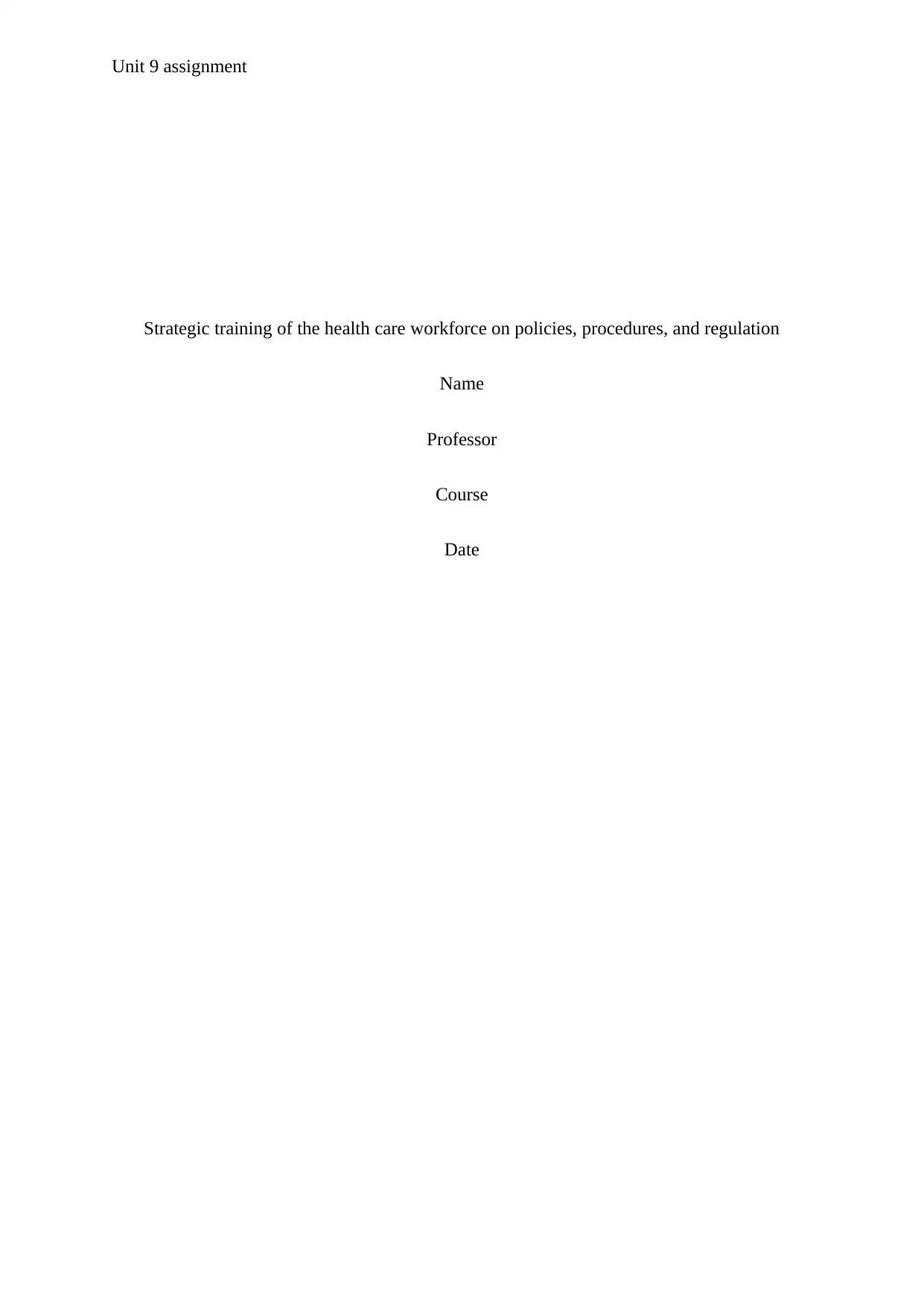
Unit 9 assignment
Strategic training of the health care workforce on policies, procedures, and regulation
Name
Professor
Course
Date
Strategic training of the health care workforce on policies, procedures, and regulation
Name
Professor
Course
Date
Paraphrase This Document
Need a fresh take? Get an instant paraphrase of this document with our AI Paraphraser
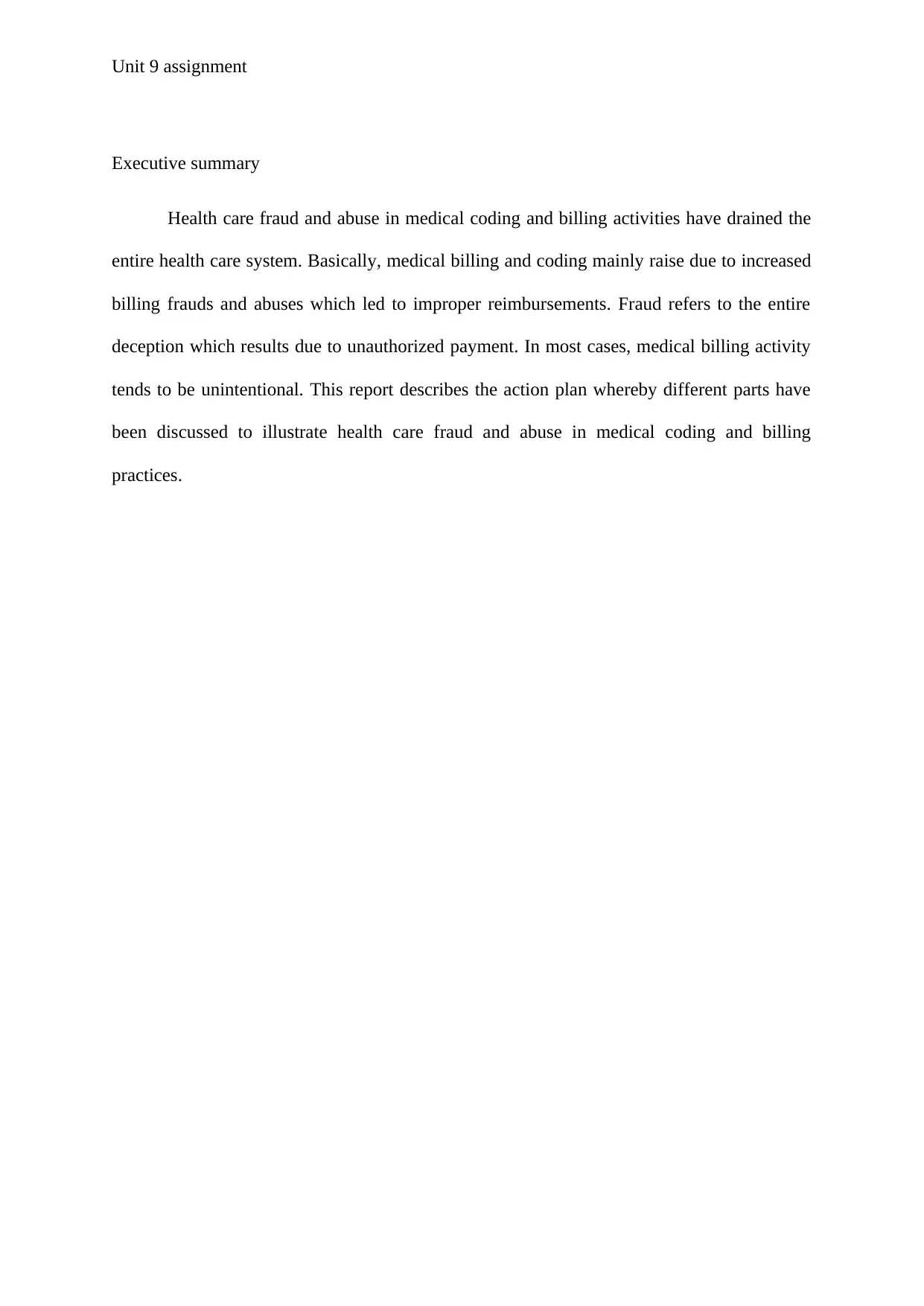
Unit 9 assignment
Executive summary
Health care fraud and abuse in medical coding and billing activities have drained the
entire health care system. Basically, medical billing and coding mainly raise due to increased
billing frauds and abuses which led to improper reimbursements. Fraud refers to the entire
deception which results due to unauthorized payment. In most cases, medical billing activity
tends to be unintentional. This report describes the action plan whereby different parts have
been discussed to illustrate health care fraud and abuse in medical coding and billing
practices.
Executive summary
Health care fraud and abuse in medical coding and billing activities have drained the
entire health care system. Basically, medical billing and coding mainly raise due to increased
billing frauds and abuses which led to improper reimbursements. Fraud refers to the entire
deception which results due to unauthorized payment. In most cases, medical billing activity
tends to be unintentional. This report describes the action plan whereby different parts have
been discussed to illustrate health care fraud and abuse in medical coding and billing
practices.
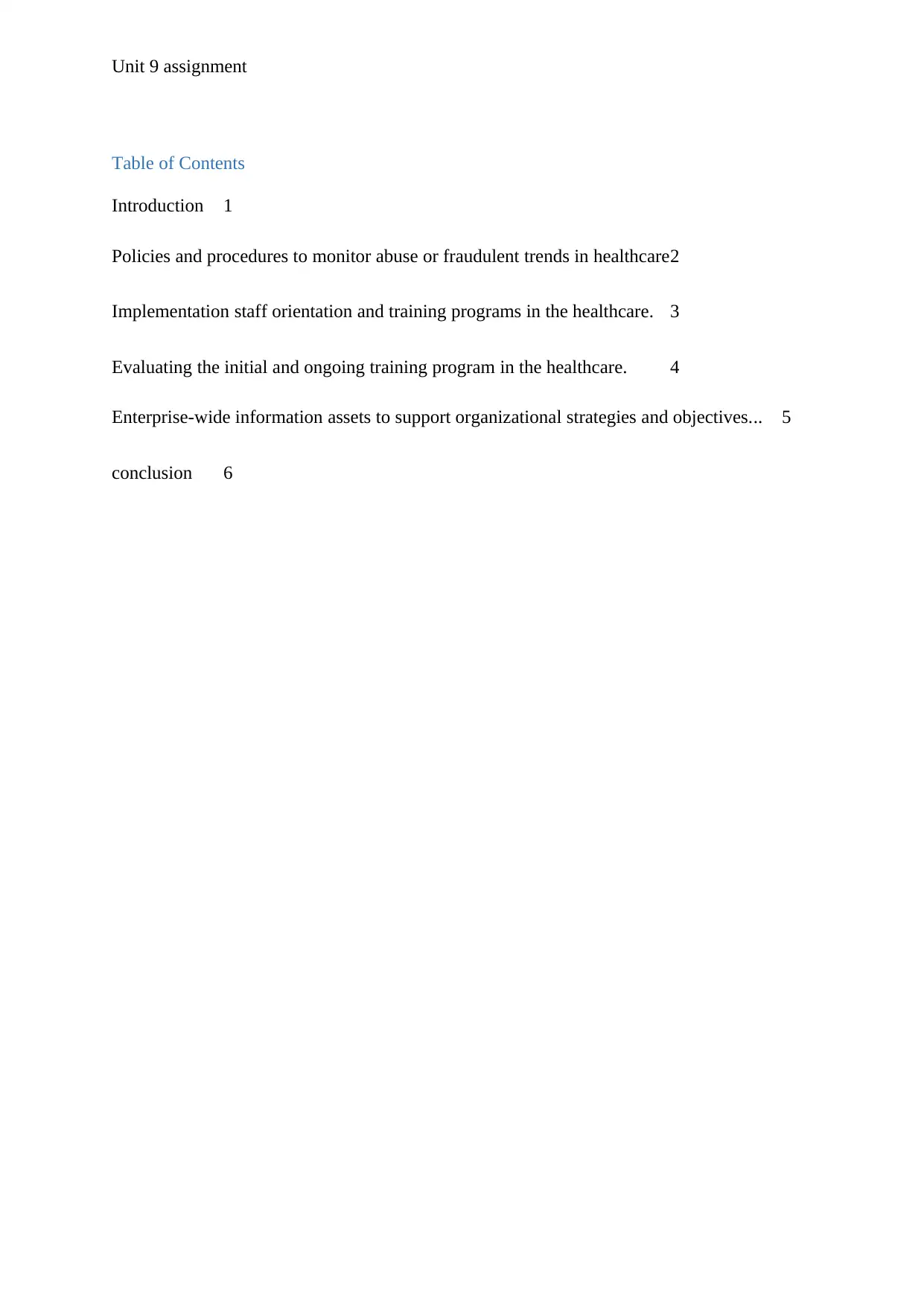
Unit 9 assignment
Table of Contents
Introduction 1
Policies and procedures to monitor abuse or fraudulent trends in healthcare2
Implementation staff orientation and training programs in the healthcare. 3
Evaluating the initial and ongoing training program in the healthcare. 4
Enterprise-wide information assets to support organizational strategies and objectives... 5
conclusion 6
Table of Contents
Introduction 1
Policies and procedures to monitor abuse or fraudulent trends in healthcare2
Implementation staff orientation and training programs in the healthcare. 3
Evaluating the initial and ongoing training program in the healthcare. 4
Enterprise-wide information assets to support organizational strategies and objectives... 5
conclusion 6
⊘ This is a preview!⊘
Do you want full access?
Subscribe today to unlock all pages.

Trusted by 1+ million students worldwide
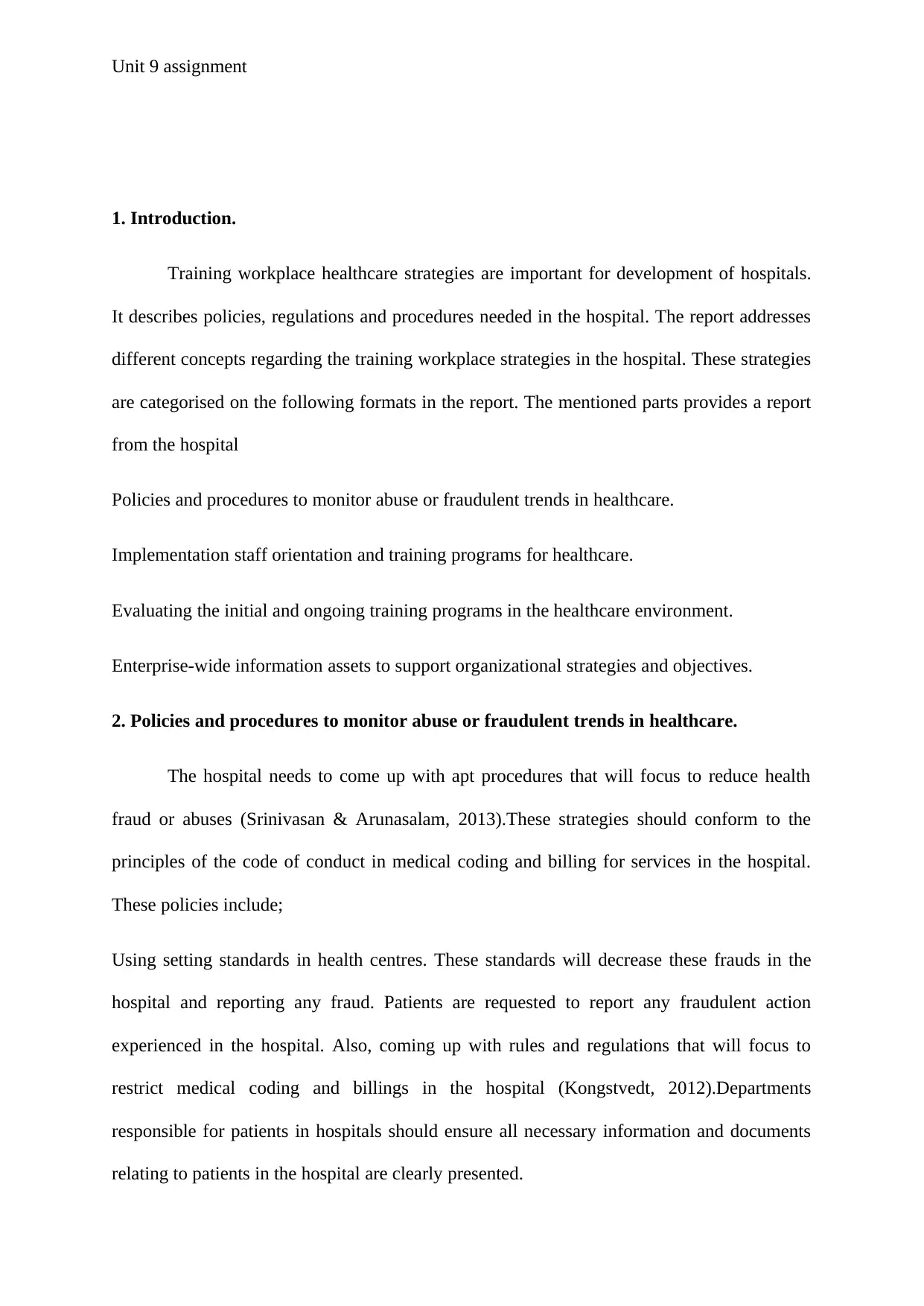
Unit 9 assignment
1. Introduction.
Training workplace healthcare strategies are important for development of hospitals.
It describes policies, regulations and procedures needed in the hospital. The report addresses
different concepts regarding the training workplace strategies in the hospital. These strategies
are categorised on the following formats in the report. The mentioned parts provides a report
from the hospital
Policies and procedures to monitor abuse or fraudulent trends in healthcare.
Implementation staff orientation and training programs for healthcare.
Evaluating the initial and ongoing training programs in the healthcare environment.
Enterprise-wide information assets to support organizational strategies and objectives.
2. Policies and procedures to monitor abuse or fraudulent trends in healthcare.
The hospital needs to come up with apt procedures that will focus to reduce health
fraud or abuses (Srinivasan & Arunasalam, 2013).These strategies should conform to the
principles of the code of conduct in medical coding and billing for services in the hospital.
These policies include;
Using setting standards in health centres. These standards will decrease these frauds in the
hospital and reporting any fraud. Patients are requested to report any fraudulent action
experienced in the hospital. Also, coming up with rules and regulations that will focus to
restrict medical coding and billings in the hospital (Kongstvedt, 2012).Departments
responsible for patients in hospitals should ensure all necessary information and documents
relating to patients in the hospital are clearly presented.
1. Introduction.
Training workplace healthcare strategies are important for development of hospitals.
It describes policies, regulations and procedures needed in the hospital. The report addresses
different concepts regarding the training workplace strategies in the hospital. These strategies
are categorised on the following formats in the report. The mentioned parts provides a report
from the hospital
Policies and procedures to monitor abuse or fraudulent trends in healthcare.
Implementation staff orientation and training programs for healthcare.
Evaluating the initial and ongoing training programs in the healthcare environment.
Enterprise-wide information assets to support organizational strategies and objectives.
2. Policies and procedures to monitor abuse or fraudulent trends in healthcare.
The hospital needs to come up with apt procedures that will focus to reduce health
fraud or abuses (Srinivasan & Arunasalam, 2013).These strategies should conform to the
principles of the code of conduct in medical coding and billing for services in the hospital.
These policies include;
Using setting standards in health centres. These standards will decrease these frauds in the
hospital and reporting any fraud. Patients are requested to report any fraudulent action
experienced in the hospital. Also, coming up with rules and regulations that will focus to
restrict medical coding and billings in the hospital (Kongstvedt, 2012).Departments
responsible for patients in hospitals should ensure all necessary information and documents
relating to patients in the hospital are clearly presented.
Paraphrase This Document
Need a fresh take? Get an instant paraphrase of this document with our AI Paraphraser
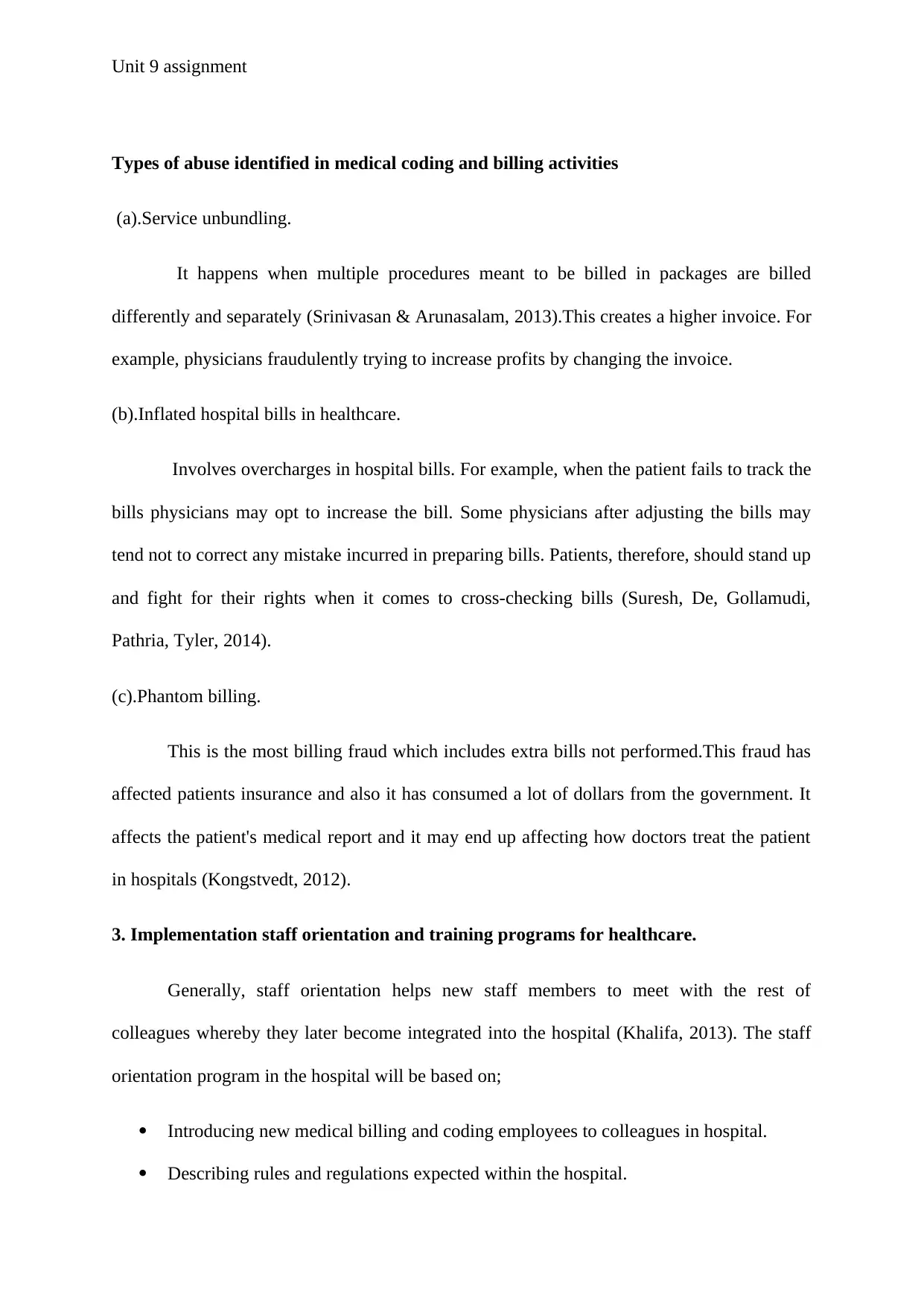
Unit 9 assignment
Types of abuse identified in medical coding and billing activities
(a).Service unbundling.
It happens when multiple procedures meant to be billed in packages are billed
differently and separately (Srinivasan & Arunasalam, 2013).This creates a higher invoice. For
example, physicians fraudulently trying to increase profits by changing the invoice.
(b).Inflated hospital bills in healthcare.
Involves overcharges in hospital bills. For example, when the patient fails to track the
bills physicians may opt to increase the bill. Some physicians after adjusting the bills may
tend not to correct any mistake incurred in preparing bills. Patients, therefore, should stand up
and fight for their rights when it comes to cross-checking bills (Suresh, De, Gollamudi,
Pathria, Tyler, 2014).
(c).Phantom billing.
This is the most billing fraud which includes extra bills not performed.This fraud has
affected patients insurance and also it has consumed a lot of dollars from the government. It
affects the patient's medical report and it may end up affecting how doctors treat the patient
in hospitals (Kongstvedt, 2012).
3. Implementation staff orientation and training programs for healthcare.
Generally, staff orientation helps new staff members to meet with the rest of
colleagues whereby they later become integrated into the hospital (Khalifa, 2013). The staff
orientation program in the hospital will be based on;
Introducing new medical billing and coding employees to colleagues in hospital.
Describing rules and regulations expected within the hospital.
Types of abuse identified in medical coding and billing activities
(a).Service unbundling.
It happens when multiple procedures meant to be billed in packages are billed
differently and separately (Srinivasan & Arunasalam, 2013).This creates a higher invoice. For
example, physicians fraudulently trying to increase profits by changing the invoice.
(b).Inflated hospital bills in healthcare.
Involves overcharges in hospital bills. For example, when the patient fails to track the
bills physicians may opt to increase the bill. Some physicians after adjusting the bills may
tend not to correct any mistake incurred in preparing bills. Patients, therefore, should stand up
and fight for their rights when it comes to cross-checking bills (Suresh, De, Gollamudi,
Pathria, Tyler, 2014).
(c).Phantom billing.
This is the most billing fraud which includes extra bills not performed.This fraud has
affected patients insurance and also it has consumed a lot of dollars from the government. It
affects the patient's medical report and it may end up affecting how doctors treat the patient
in hospitals (Kongstvedt, 2012).
3. Implementation staff orientation and training programs for healthcare.
Generally, staff orientation helps new staff members to meet with the rest of
colleagues whereby they later become integrated into the hospital (Khalifa, 2013). The staff
orientation program in the hospital will be based on;
Introducing new medical billing and coding employees to colleagues in hospital.
Describing rules and regulations expected within the hospital.
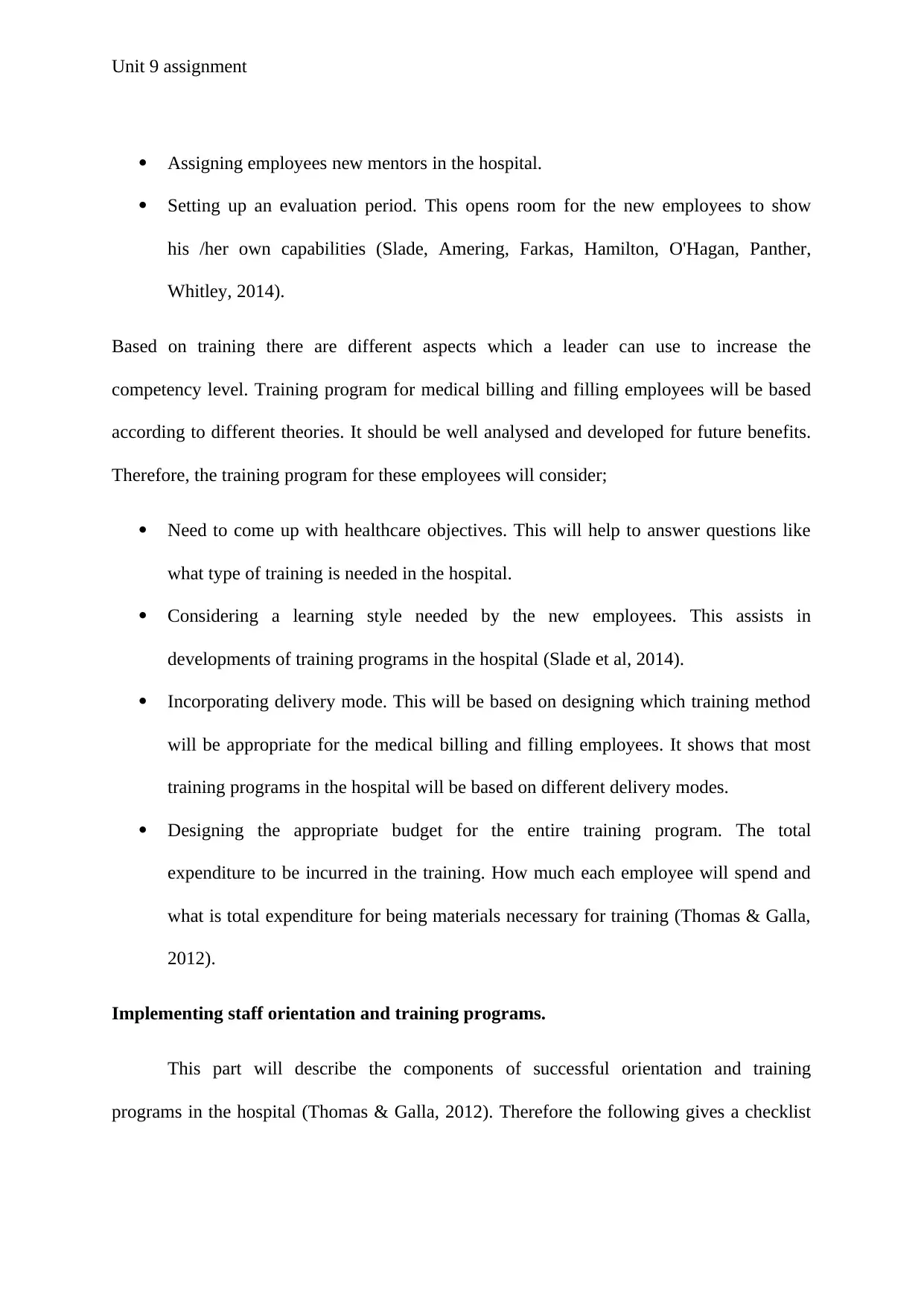
Unit 9 assignment
Assigning employees new mentors in the hospital.
Setting up an evaluation period. This opens room for the new employees to show
his /her own capabilities (Slade, Amering, Farkas, Hamilton, O'Hagan, Panther,
Whitley, 2014).
Based on training there are different aspects which a leader can use to increase the
competency level. Training program for medical billing and filling employees will be based
according to different theories. It should be well analysed and developed for future benefits.
Therefore, the training program for these employees will consider;
Need to come up with healthcare objectives. This will help to answer questions like
what type of training is needed in the hospital.
Considering a learning style needed by the new employees. This assists in
developments of training programs in the hospital (Slade et al, 2014).
Incorporating delivery mode. This will be based on designing which training method
will be appropriate for the medical billing and filling employees. It shows that most
training programs in the hospital will be based on different delivery modes.
Designing the appropriate budget for the entire training program. The total
expenditure to be incurred in the training. How much each employee will spend and
what is total expenditure for being materials necessary for training (Thomas & Galla,
2012).
Implementing staff orientation and training programs.
This part will describe the components of successful orientation and training
programs in the hospital (Thomas & Galla, 2012). Therefore the following gives a checklist
Assigning employees new mentors in the hospital.
Setting up an evaluation period. This opens room for the new employees to show
his /her own capabilities (Slade, Amering, Farkas, Hamilton, O'Hagan, Panther,
Whitley, 2014).
Based on training there are different aspects which a leader can use to increase the
competency level. Training program for medical billing and filling employees will be based
according to different theories. It should be well analysed and developed for future benefits.
Therefore, the training program for these employees will consider;
Need to come up with healthcare objectives. This will help to answer questions like
what type of training is needed in the hospital.
Considering a learning style needed by the new employees. This assists in
developments of training programs in the hospital (Slade et al, 2014).
Incorporating delivery mode. This will be based on designing which training method
will be appropriate for the medical billing and filling employees. It shows that most
training programs in the hospital will be based on different delivery modes.
Designing the appropriate budget for the entire training program. The total
expenditure to be incurred in the training. How much each employee will spend and
what is total expenditure for being materials necessary for training (Thomas & Galla,
2012).
Implementing staff orientation and training programs.
This part will describe the components of successful orientation and training
programs in the hospital (Thomas & Galla, 2012). Therefore the following gives a checklist
⊘ This is a preview!⊘
Do you want full access?
Subscribe today to unlock all pages.

Trusted by 1+ million students worldwide
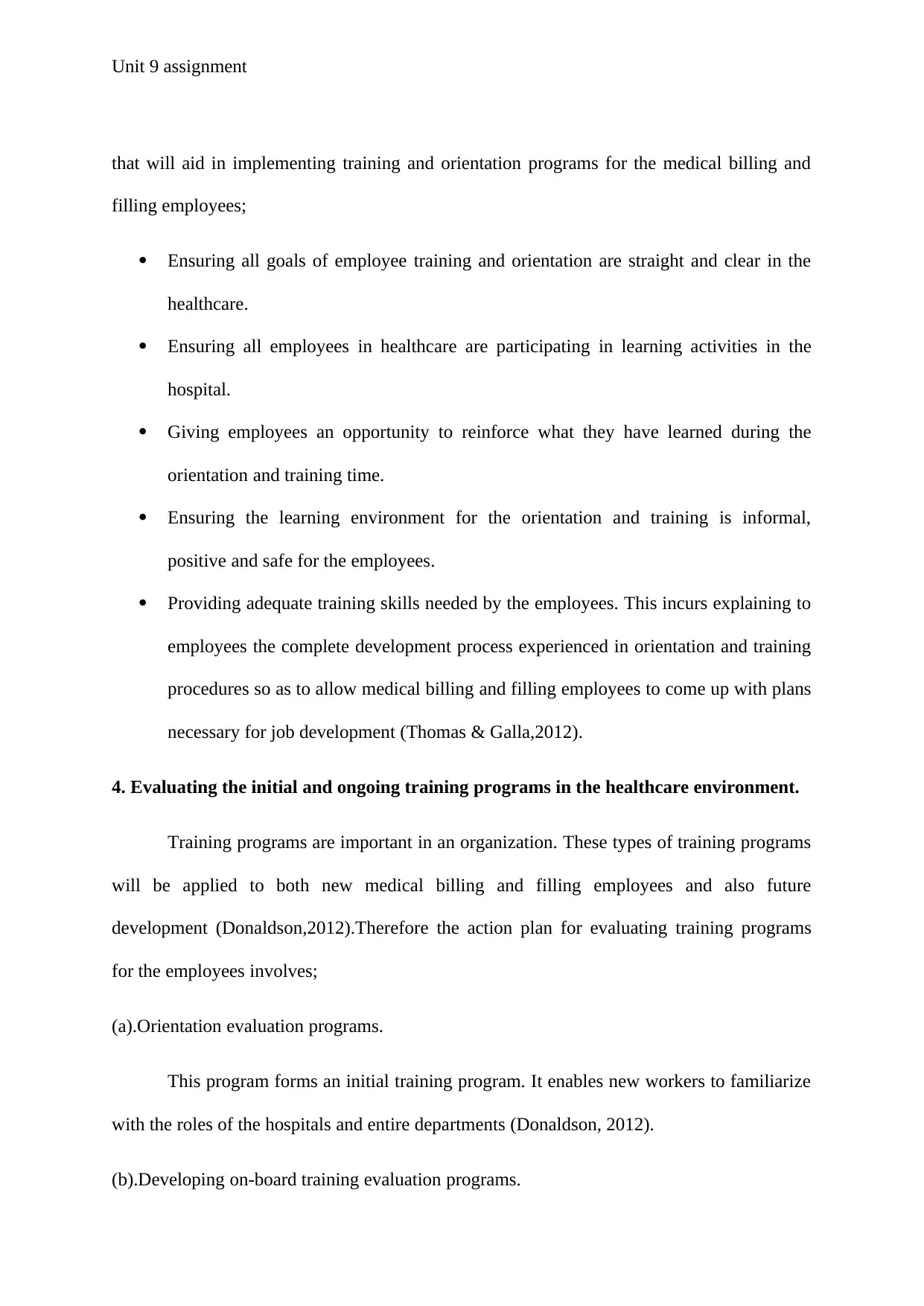
Unit 9 assignment
that will aid in implementing training and orientation programs for the medical billing and
filling employees;
Ensuring all goals of employee training and orientation are straight and clear in the
healthcare.
Ensuring all employees in healthcare are participating in learning activities in the
hospital.
Giving employees an opportunity to reinforce what they have learned during the
orientation and training time.
Ensuring the learning environment for the orientation and training is informal,
positive and safe for the employees.
Providing adequate training skills needed by the employees. This incurs explaining to
employees the complete development process experienced in orientation and training
procedures so as to allow medical billing and filling employees to come up with plans
necessary for job development (Thomas & Galla,2012).
4. Evaluating the initial and ongoing training programs in the healthcare environment.
Training programs are important in an organization. These types of training programs
will be applied to both new medical billing and filling employees and also future
development (Donaldson,2012).Therefore the action plan for evaluating training programs
for the employees involves;
(a).Orientation evaluation programs.
This program forms an initial training program. It enables new workers to familiarize
with the roles of the hospitals and entire departments (Donaldson, 2012).
(b).Developing on-board training evaluation programs.
that will aid in implementing training and orientation programs for the medical billing and
filling employees;
Ensuring all goals of employee training and orientation are straight and clear in the
healthcare.
Ensuring all employees in healthcare are participating in learning activities in the
hospital.
Giving employees an opportunity to reinforce what they have learned during the
orientation and training time.
Ensuring the learning environment for the orientation and training is informal,
positive and safe for the employees.
Providing adequate training skills needed by the employees. This incurs explaining to
employees the complete development process experienced in orientation and training
procedures so as to allow medical billing and filling employees to come up with plans
necessary for job development (Thomas & Galla,2012).
4. Evaluating the initial and ongoing training programs in the healthcare environment.
Training programs are important in an organization. These types of training programs
will be applied to both new medical billing and filling employees and also future
development (Donaldson,2012).Therefore the action plan for evaluating training programs
for the employees involves;
(a).Orientation evaluation programs.
This program forms an initial training program. It enables new workers to familiarize
with the roles of the hospitals and entire departments (Donaldson, 2012).
(b).Developing on-board training evaluation programs.
Paraphrase This Document
Need a fresh take? Get an instant paraphrase of this document with our AI Paraphraser
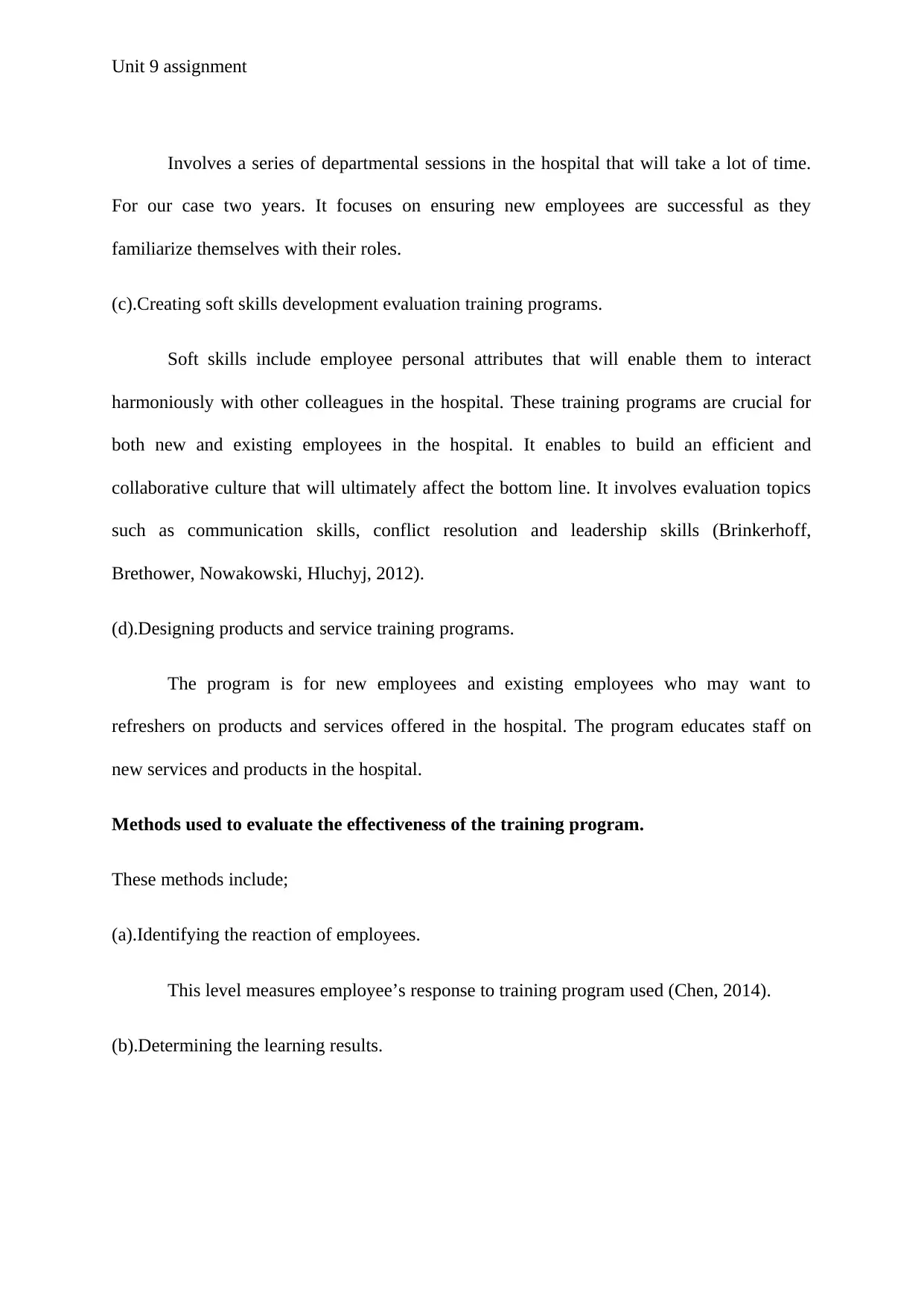
Unit 9 assignment
Involves a series of departmental sessions in the hospital that will take a lot of time.
For our case two years. It focuses on ensuring new employees are successful as they
familiarize themselves with their roles.
(c).Creating soft skills development evaluation training programs.
Soft skills include employee personal attributes that will enable them to interact
harmoniously with other colleagues in the hospital. These training programs are crucial for
both new and existing employees in the hospital. It enables to build an efficient and
collaborative culture that will ultimately affect the bottom line. It involves evaluation topics
such as communication skills, conflict resolution and leadership skills (Brinkerhoff,
Brethower, Nowakowski, Hluchyj, 2012).
(d).Designing products and service training programs.
The program is for new employees and existing employees who may want to
refreshers on products and services offered in the hospital. The program educates staff on
new services and products in the hospital.
Methods used to evaluate the effectiveness of the training program.
These methods include;
(a).Identifying the reaction of employees.
This level measures employee’s response to training program used (Chen, 2014).
(b).Determining the learning results.
Involves a series of departmental sessions in the hospital that will take a lot of time.
For our case two years. It focuses on ensuring new employees are successful as they
familiarize themselves with their roles.
(c).Creating soft skills development evaluation training programs.
Soft skills include employee personal attributes that will enable them to interact
harmoniously with other colleagues in the hospital. These training programs are crucial for
both new and existing employees in the hospital. It enables to build an efficient and
collaborative culture that will ultimately affect the bottom line. It involves evaluation topics
such as communication skills, conflict resolution and leadership skills (Brinkerhoff,
Brethower, Nowakowski, Hluchyj, 2012).
(d).Designing products and service training programs.
The program is for new employees and existing employees who may want to
refreshers on products and services offered in the hospital. The program educates staff on
new services and products in the hospital.
Methods used to evaluate the effectiveness of the training program.
These methods include;
(a).Identifying the reaction of employees.
This level measures employee’s response to training program used (Chen, 2014).
(b).Determining the learning results.
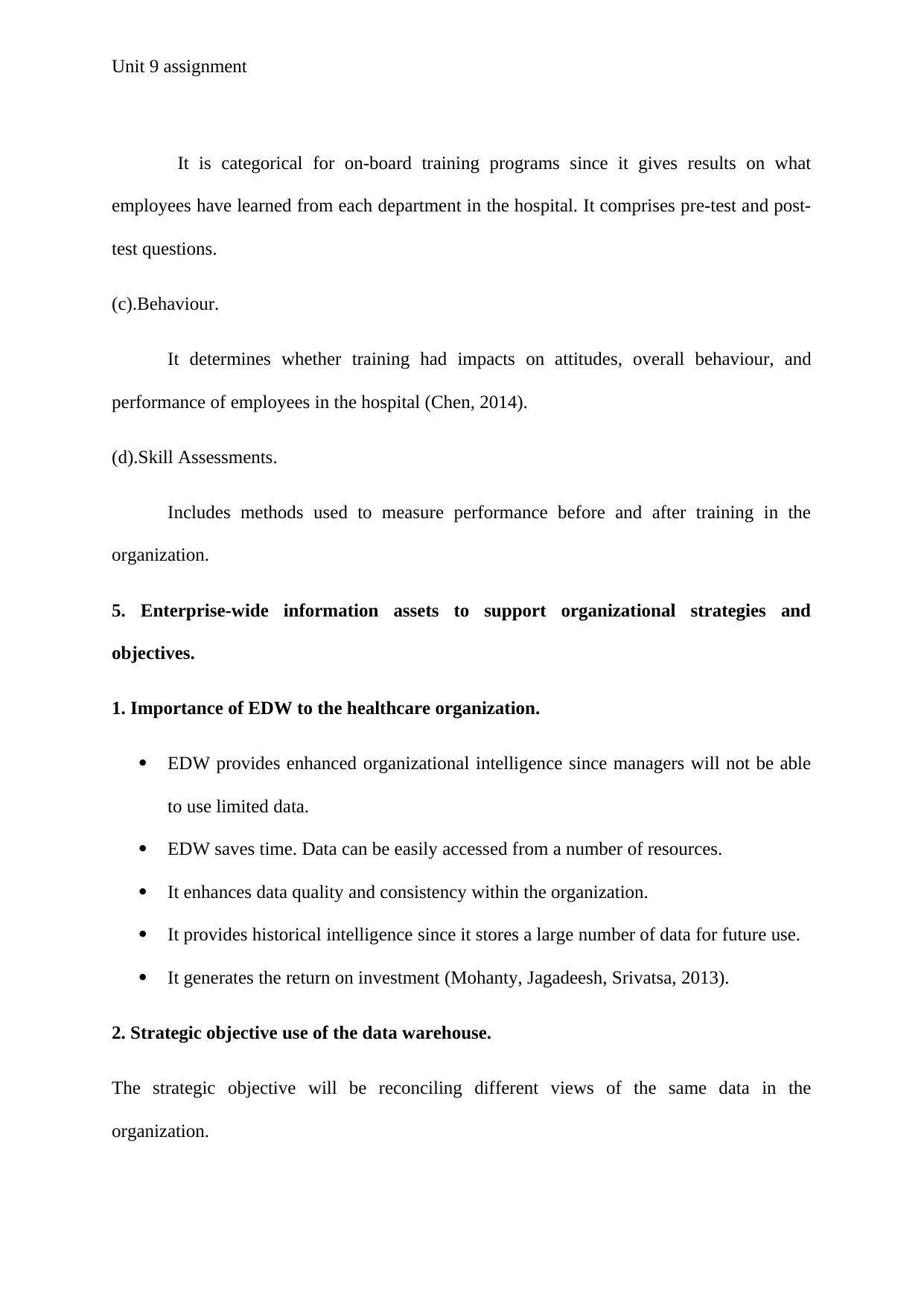
Unit 9 assignment
It is categorical for on-board training programs since it gives results on what
employees have learned from each department in the hospital. It comprises pre-test and post-
test questions.
(c).Behaviour.
It determines whether training had impacts on attitudes, overall behaviour, and
performance of employees in the hospital (Chen, 2014).
(d).Skill Assessments.
Includes methods used to measure performance before and after training in the
organization.
5. Enterprise-wide information assets to support organizational strategies and
objectives.
1. Importance of EDW to the healthcare organization.
EDW provides enhanced organizational intelligence since managers will not be able
to use limited data.
EDW saves time. Data can be easily accessed from a number of resources.
It enhances data quality and consistency within the organization.
It provides historical intelligence since it stores a large number of data for future use.
It generates the return on investment (Mohanty, Jagadeesh, Srivatsa, 2013).
2. Strategic objective use of the data warehouse.
The strategic objective will be reconciling different views of the same data in the
organization.
It is categorical for on-board training programs since it gives results on what
employees have learned from each department in the hospital. It comprises pre-test and post-
test questions.
(c).Behaviour.
It determines whether training had impacts on attitudes, overall behaviour, and
performance of employees in the hospital (Chen, 2014).
(d).Skill Assessments.
Includes methods used to measure performance before and after training in the
organization.
5. Enterprise-wide information assets to support organizational strategies and
objectives.
1. Importance of EDW to the healthcare organization.
EDW provides enhanced organizational intelligence since managers will not be able
to use limited data.
EDW saves time. Data can be easily accessed from a number of resources.
It enhances data quality and consistency within the organization.
It provides historical intelligence since it stores a large number of data for future use.
It generates the return on investment (Mohanty, Jagadeesh, Srivatsa, 2013).
2. Strategic objective use of the data warehouse.
The strategic objective will be reconciling different views of the same data in the
organization.
⊘ This is a preview!⊘
Do you want full access?
Subscribe today to unlock all pages.

Trusted by 1+ million students worldwide
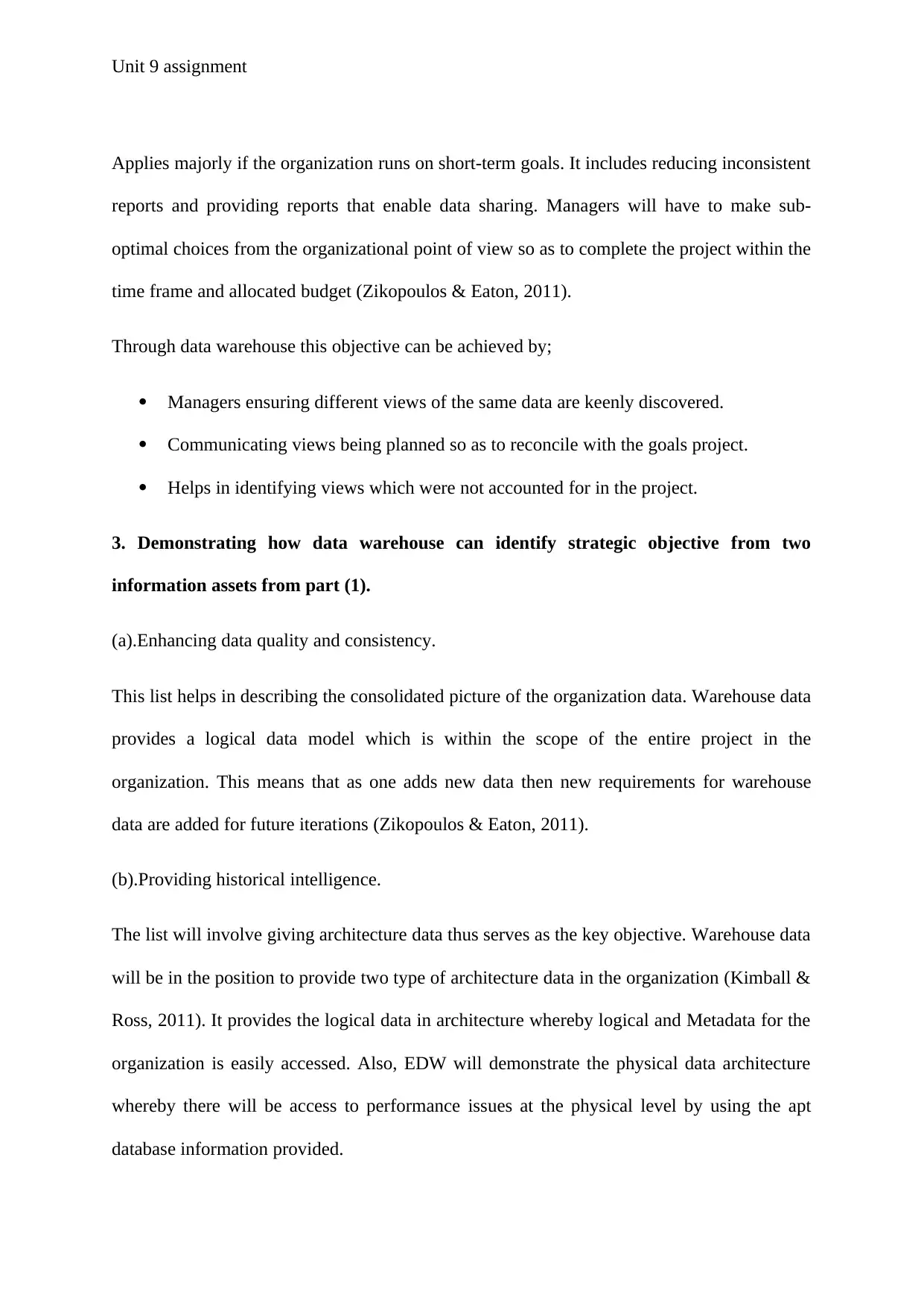
Unit 9 assignment
Applies majorly if the organization runs on short-term goals. It includes reducing inconsistent
reports and providing reports that enable data sharing. Managers will have to make sub-
optimal choices from the organizational point of view so as to complete the project within the
time frame and allocated budget (Zikopoulos & Eaton, 2011).
Through data warehouse this objective can be achieved by;
Managers ensuring different views of the same data are keenly discovered.
Communicating views being planned so as to reconcile with the goals project.
Helps in identifying views which were not accounted for in the project.
3. Demonstrating how data warehouse can identify strategic objective from two
information assets from part (1).
(a).Enhancing data quality and consistency.
This list helps in describing the consolidated picture of the organization data. Warehouse data
provides a logical data model which is within the scope of the entire project in the
organization. This means that as one adds new data then new requirements for warehouse
data are added for future iterations (Zikopoulos & Eaton, 2011).
(b).Providing historical intelligence.
The list will involve giving architecture data thus serves as the key objective. Warehouse data
will be in the position to provide two type of architecture data in the organization (Kimball &
Ross, 2011). It provides the logical data in architecture whereby logical and Metadata for the
organization is easily accessed. Also, EDW will demonstrate the physical data architecture
whereby there will be access to performance issues at the physical level by using the apt
database information provided.
Applies majorly if the organization runs on short-term goals. It includes reducing inconsistent
reports and providing reports that enable data sharing. Managers will have to make sub-
optimal choices from the organizational point of view so as to complete the project within the
time frame and allocated budget (Zikopoulos & Eaton, 2011).
Through data warehouse this objective can be achieved by;
Managers ensuring different views of the same data are keenly discovered.
Communicating views being planned so as to reconcile with the goals project.
Helps in identifying views which were not accounted for in the project.
3. Demonstrating how data warehouse can identify strategic objective from two
information assets from part (1).
(a).Enhancing data quality and consistency.
This list helps in describing the consolidated picture of the organization data. Warehouse data
provides a logical data model which is within the scope of the entire project in the
organization. This means that as one adds new data then new requirements for warehouse
data are added for future iterations (Zikopoulos & Eaton, 2011).
(b).Providing historical intelligence.
The list will involve giving architecture data thus serves as the key objective. Warehouse data
will be in the position to provide two type of architecture data in the organization (Kimball &
Ross, 2011). It provides the logical data in architecture whereby logical and Metadata for the
organization is easily accessed. Also, EDW will demonstrate the physical data architecture
whereby there will be access to performance issues at the physical level by using the apt
database information provided.
Paraphrase This Document
Need a fresh take? Get an instant paraphrase of this document with our AI Paraphraser
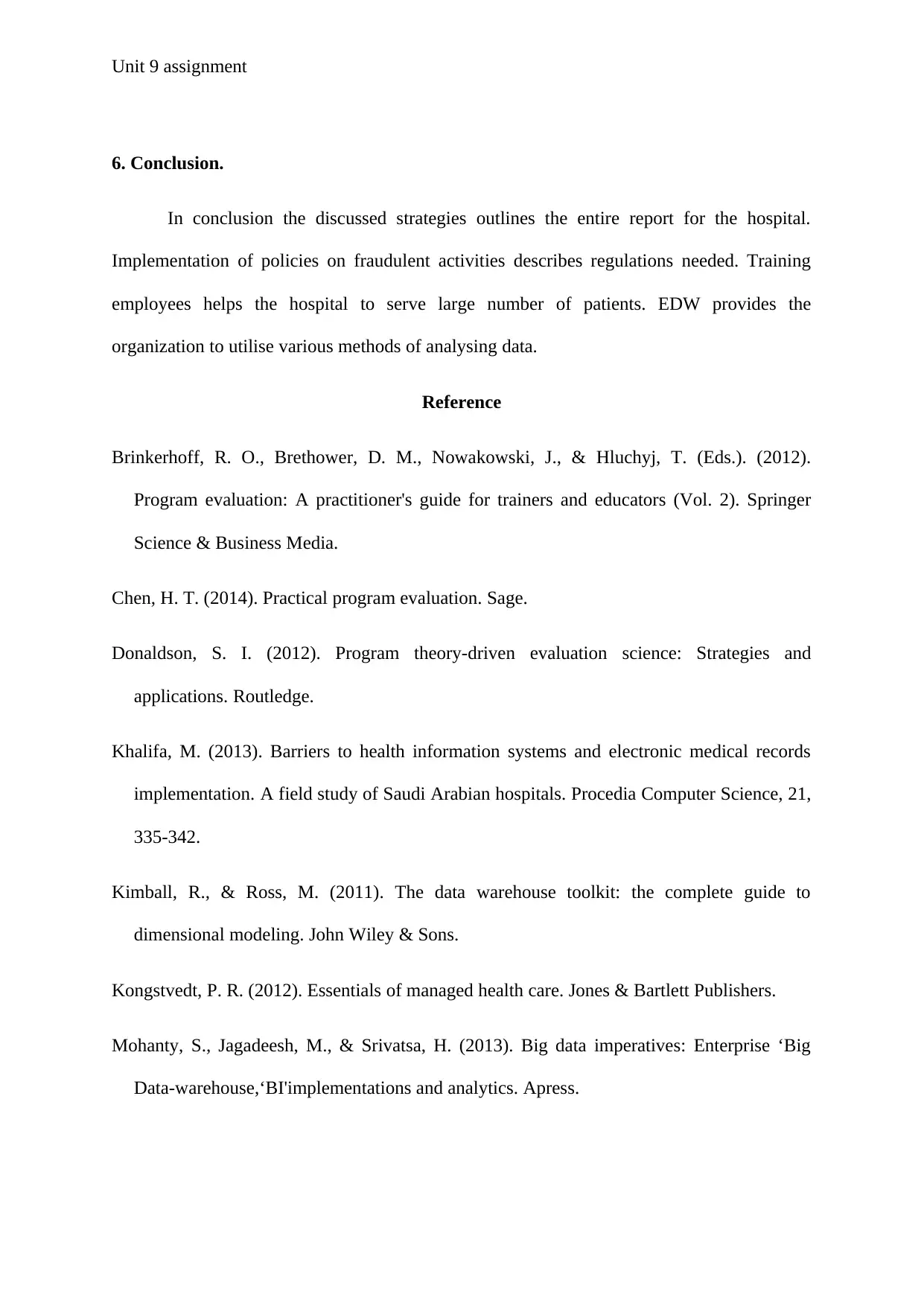
Unit 9 assignment
6. Conclusion.
In conclusion the discussed strategies outlines the entire report for the hospital.
Implementation of policies on fraudulent activities describes regulations needed. Training
employees helps the hospital to serve large number of patients. EDW provides the
organization to utilise various methods of analysing data.
Reference
Brinkerhoff, R. O., Brethower, D. M., Nowakowski, J., & Hluchyj, T. (Eds.). (2012).
Program evaluation: A practitioner's guide for trainers and educators (Vol. 2). Springer
Science & Business Media.
Chen, H. T. (2014). Practical program evaluation. Sage.
Donaldson, S. I. (2012). Program theory-driven evaluation science: Strategies and
applications. Routledge.
Khalifa, M. (2013). Barriers to health information systems and electronic medical records
implementation. A field study of Saudi Arabian hospitals. Procedia Computer Science, 21,
335-342.
Kimball, R., & Ross, M. (2011). The data warehouse toolkit: the complete guide to
dimensional modeling. John Wiley & Sons.
Kongstvedt, P. R. (2012). Essentials of managed health care. Jones & Bartlett Publishers.
Mohanty, S., Jagadeesh, M., & Srivatsa, H. (2013). Big data imperatives: Enterprise ‘Big
Data-warehouse,‘BI'implementations and analytics. Apress.
6. Conclusion.
In conclusion the discussed strategies outlines the entire report for the hospital.
Implementation of policies on fraudulent activities describes regulations needed. Training
employees helps the hospital to serve large number of patients. EDW provides the
organization to utilise various methods of analysing data.
Reference
Brinkerhoff, R. O., Brethower, D. M., Nowakowski, J., & Hluchyj, T. (Eds.). (2012).
Program evaluation: A practitioner's guide for trainers and educators (Vol. 2). Springer
Science & Business Media.
Chen, H. T. (2014). Practical program evaluation. Sage.
Donaldson, S. I. (2012). Program theory-driven evaluation science: Strategies and
applications. Routledge.
Khalifa, M. (2013). Barriers to health information systems and electronic medical records
implementation. A field study of Saudi Arabian hospitals. Procedia Computer Science, 21,
335-342.
Kimball, R., & Ross, M. (2011). The data warehouse toolkit: the complete guide to
dimensional modeling. John Wiley & Sons.
Kongstvedt, P. R. (2012). Essentials of managed health care. Jones & Bartlett Publishers.
Mohanty, S., Jagadeesh, M., & Srivatsa, H. (2013). Big data imperatives: Enterprise ‘Big
Data-warehouse,‘BI'implementations and analytics. Apress.
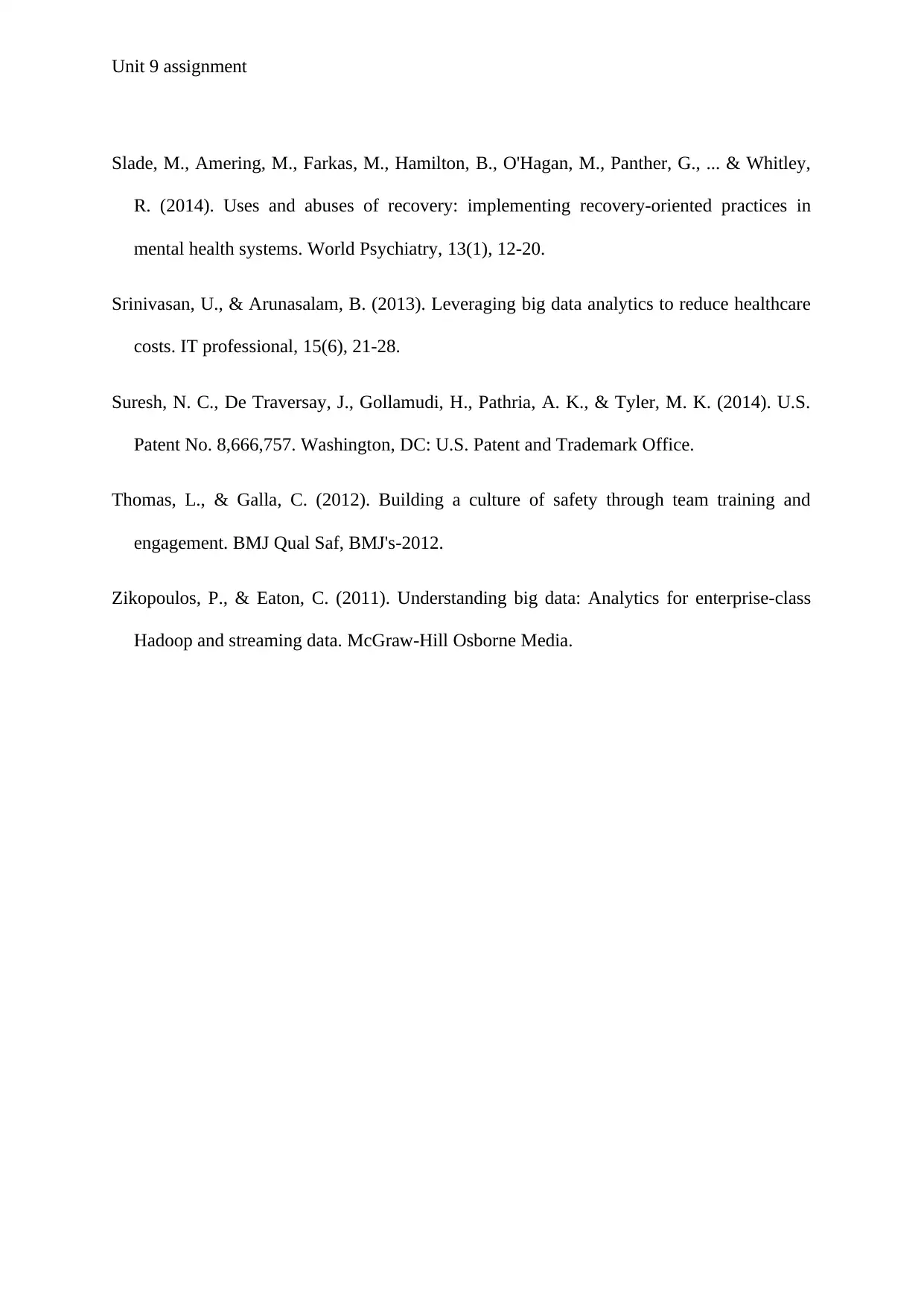
Unit 9 assignment
Slade, M., Amering, M., Farkas, M., Hamilton, B., O'Hagan, M., Panther, G., ... & Whitley,
R. (2014). Uses and abuses of recovery: implementing recovery‐oriented practices in
mental health systems. World Psychiatry, 13(1), 12-20.
Srinivasan, U., & Arunasalam, B. (2013). Leveraging big data analytics to reduce healthcare
costs. IT professional, 15(6), 21-28.
Suresh, N. C., De Traversay, J., Gollamudi, H., Pathria, A. K., & Tyler, M. K. (2014). U.S.
Patent No. 8,666,757. Washington, DC: U.S. Patent and Trademark Office.
Thomas, L., & Galla, C. (2012). Building a culture of safety through team training and
engagement. BMJ Qual Saf, BMJ's-2012.
Zikopoulos, P., & Eaton, C. (2011). Understanding big data: Analytics for enterprise-class
Hadoop and streaming data. McGraw-Hill Osborne Media.
Slade, M., Amering, M., Farkas, M., Hamilton, B., O'Hagan, M., Panther, G., ... & Whitley,
R. (2014). Uses and abuses of recovery: implementing recovery‐oriented practices in
mental health systems. World Psychiatry, 13(1), 12-20.
Srinivasan, U., & Arunasalam, B. (2013). Leveraging big data analytics to reduce healthcare
costs. IT professional, 15(6), 21-28.
Suresh, N. C., De Traversay, J., Gollamudi, H., Pathria, A. K., & Tyler, M. K. (2014). U.S.
Patent No. 8,666,757. Washington, DC: U.S. Patent and Trademark Office.
Thomas, L., & Galla, C. (2012). Building a culture of safety through team training and
engagement. BMJ Qual Saf, BMJ's-2012.
Zikopoulos, P., & Eaton, C. (2011). Understanding big data: Analytics for enterprise-class
Hadoop and streaming data. McGraw-Hill Osborne Media.
⊘ This is a preview!⊘
Do you want full access?
Subscribe today to unlock all pages.

Trusted by 1+ million students worldwide
1 out of 12
Related Documents
Your All-in-One AI-Powered Toolkit for Academic Success.
+13062052269
info@desklib.com
Available 24*7 on WhatsApp / Email
![[object Object]](/_next/static/media/star-bottom.7253800d.svg)
Unlock your academic potential
Copyright © 2020–2025 A2Z Services. All Rights Reserved. Developed and managed by ZUCOL.




